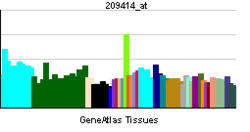FZR1
Fizzy-related protein homolog is a protein that in humans is encoded by the FZR1 gene.[1][2][3]
Interactions
FZR1 has been shown to interact with CDC27[4][5] and FBXO5.[6]
References
- ↑ Fang G, Yu H, Kirschner MW (Sep 1998). "Direct binding of CDC20 protein family members activates the anaphase-promoting complex in mitosis and G1". Mol Cell 2 (2): 163–171. doi:10.1016/S1097-2765(00)80126-4. PMID 9734353.
- ↑ Sorensen CS, Lukas C, Kramer ER, Peters JM, Bartek J, Lukas J (Oct 2000). "Nonperiodic activity of the human anaphase-promoting complex-Cdh1 ubiquitin ligase results in continuous DNA synthesis uncoupled from mitosis". Mol Cell Biol 20 (20): 7613–7623. doi:10.1128/MCB.20.20.7613-7623.2000. PMC 86321. PMID 11003657.
- ↑ "Entrez Gene: FZR1 fizzy/cell division cycle 20 related 1 (Drosophila)".
- ↑ Zhou, Yuan; Ching Yick-Pang; Ng Raymond W M; Jin Dong-Yan (Sep 2003). "Differential expression, localization and activity of two alternatively spliced isoforms of human APC regulator CDH1". Biochem. J. (England) 374 (Pt 2): 349–58. doi:10.1042/BJ20030600. PMC 1223613. PMID 12797865.
- ↑ Kramer, E R; Gieffers C; Hölzl G; Hengstschläger M; Peters J M (Nov 1998). "Activation of the human anaphase-promoting complex by proteins of the CDC20/Fizzy family". Curr. Biol. (ENGLAND) 8 (22): 1207–S4. doi:10.1016/S0960-9822(07)00510-6. ISSN 0960-9822. PMID 9811605.
- ↑ Hsu, Jerry Y; Reimann Julie D R; Sørensen Claus S; Lukas Jiri; Jackson Peter K (May 2002). "E2F-dependent accumulation of hEmi1 regulates S phase entry by inhibiting APC(Cdh1)". Nat. Cell Biol. (England) 4 (5): 358–366. doi:10.1038/ncb785. ISSN 1465-7392. PMID 11988738.
Further reading
- Kramer ER; Gieffers C; Hölzl G et al. (1999). "Activation of the human anaphase-promoting complex by proteins of the CDC20/Fizzy family". Curr. Biol. 8 (22): 1207–S4. doi:10.1016/S0960-9822(07)00510-6. PMID 9811605.
- Kotani S, Tanaka H, Yasuda H, Todokoro K (1999). "Regulation of APC activity by phosphorylation and regulatory factors". J. Cell Biol. 146 (4): 791–800. doi:10.1083/jcb.146.4.791. PMC 2156135. PMID 10459014. (Retracted. If this is intentional, please replace
{{Retracted}}with{{Retracted|intentional=yes}}.) - Gieffers C; Peters BH; Kramer ER et al. (1999). "Expression of the CDH1-associated form of the anaphase-promoting complex in postmitotic neurons". Proc. Natl. Acad. Sci. U.S.A. 96 (20): 11317–11322. doi:10.1073/pnas.96.20.11317. PMC 18031. PMID 10500174.
- Nagase T; Ishikawa K; Kikuno R et al. (2000). "Prediction of the coding sequences of unidentified human genes. XV. The complete sequences of 100 new cDNA clones from brain which code for large proteins in vitro". DNA Res. 6 (5): 337–345. doi:10.1093/dnares/6.5.337. PMID 10574462.
- Bembenek J, Yu H (2002). "Regulation of the anaphase-promoting complex by the dual specificity phosphatase human Cdc14a". J. Biol. Chem. 276 (51): 48237–42. doi:10.1074/jbc.M108126200. PMID 11598127.
- Stroschein SL, Bonni S, Wrana JL, Luo K (2001). "Smad3 recruits the anaphase-promoting complex for ubiquitination and degradation of SnoN". Genes Dev. 15 (21): 2822–36. doi:10.1101/gad.912901. PMC 312804. PMID 11691834.
- Hsu JY; Reimann JD; Sørensen CS et al. (2002). "E2F-dependent accumulation of hEmi1 regulates S phase entry by inhibiting APC(Cdh1)". Nat. Cell Biol. 4 (5): 358–366. doi:10.1038/ncb785. PMID 11988738.
- Zur A, Brandeis M (2002). "Timing of APC/C substrate degradation is determined by fzy/fzr specificity of destruction boxes". EMBO J. 21 (17): 4500–4510. doi:10.1093/emboj/cdf452. PMC 126191. PMID 12198152.
- Strausberg RL; Feingold EA; Grouse LH et al. (2003). "Generation and initial analysis of more than 15,000 full-length human and mouse cDNA sequences". Proc. Natl. Acad. Sci. U.S.A. 99 (26): 16899–16903. doi:10.1073/pnas.242603899. PMC 139241. PMID 12477932.
- Zhou Y, Ching YP, Chun AC, Jin DY (2003). "Nuclear localization of the cell cycle regulator CDH1 and its regulation by phosphorylation". J. Biol. Chem. 278 (14): 12530–12536. doi:10.1074/jbc.M212853200. PMID 12560341.
- Zhou Y, Ching YP, Ng RW, Jin DY (2003). "Differential expression, localization and activity of two alternatively spliced isoforms of human APC regulator CDH1". Biochem. J. 374 (Pt 2): 349–58. doi:10.1042/BJ20030600. PMC 1223613. PMID 12797865.
- Vodermaier HC; Gieffers C; Maurer-Stroh S et al. (2004). "TPR subunits of the anaphase-promoting complex mediate binding to the activator protein CDH1". Curr. Biol. 13 (17): 1459–1468. doi:10.1016/S0960-9822(03)00581-5. PMID 12956947.
- Wei W; Ayad NG; Wan Y et al. (2004). "Degradation of the SCF component Skp2 in cell-cycle phase G1 by the anaphase-promoting complex". Nature 428 (6979): 194–198. doi:10.1038/nature02381. PMID 15014503.
- Listovsky T; Oren YS; Yudkovsky Y et al. (2005). "Mammalian Cdh1/Fzr mediates its own degradation". EMBO J. 23 (7): 1619–1626. doi:10.1038/sj.emboj.7600149. PMC 391060. PMID 15029244.
- Grimwood J; Gordon LA; Olsen A et al. (2004). "The DNA sequence and biology of human chromosome 19". Nature 428 (6982): 529–535. doi:10.1038/nature02399. PMID 15057824.
- Nourry C; Maksumova L; Pang M et al. (2005). "Direct interaction between Smad3, APC10, CDH1 and HEF1 in proteasomal degradation of HEF1". BMC Cell Biol. 5: 20. doi:10.1186/1471-2121-5-20. PMC 420458. PMID 15144564.
- Gerhard DS; Wagner L; Feingold EA et al. (2004). "The status, quality, and expansion of the NIH full-length cDNA project: the Mammalian Gene Collection (MGC)". Genome Res. 14 (10B): 2121–2127. doi:10.1101/gr.2596504. PMC 528928. PMID 15489334.
- Kraft C; Vodermaier HC; Maurer-Stroh S et al. (2005). "The WD40 propeller domain of Cdh1 functions as a destruction box receptor for APC/C substrates". Mol. Cell 18 (5): 543–553. doi:10.1016/j.molcel.2005.04.023. PMID 15916961.


